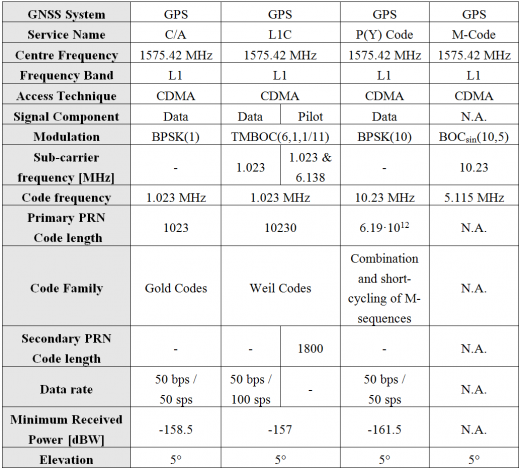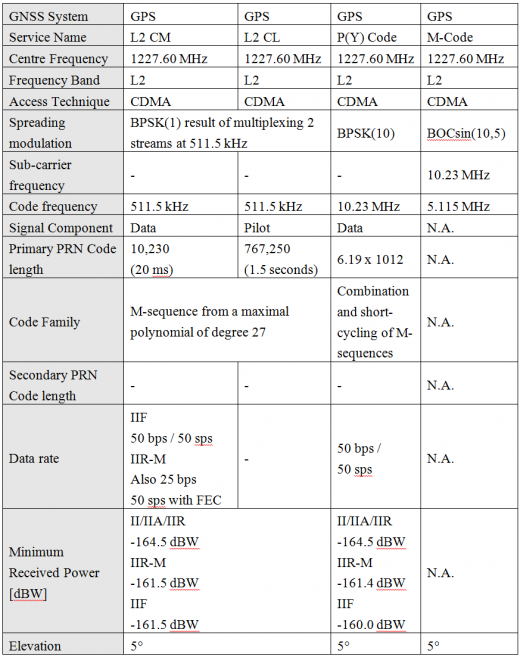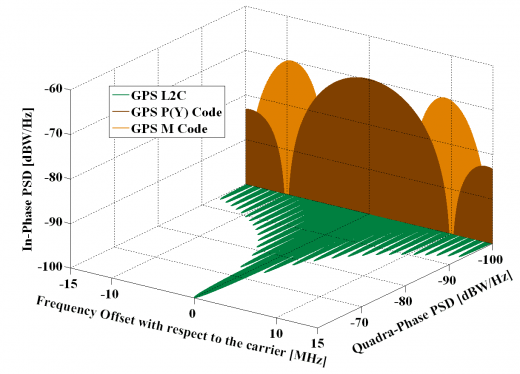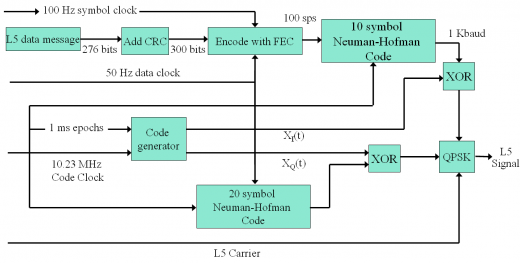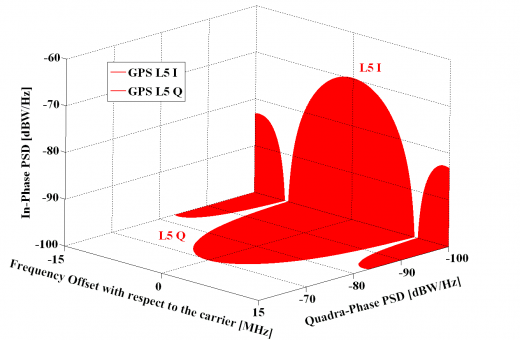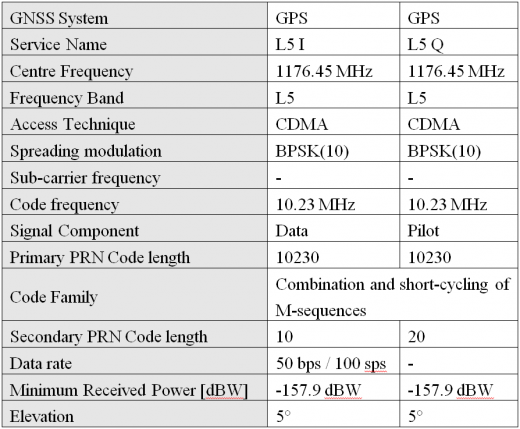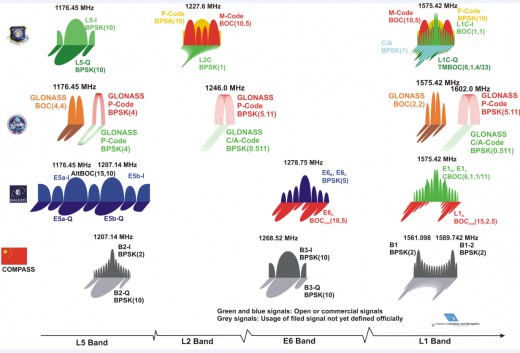If you wish to contribute or participate in the discussions about articles you are invited to contact the Editor
GPS Signal Plan: Difference between revisions
Carlos.Lopez (talk | contribs) No edit summary |
Carlos.Lopez (talk | contribs) No edit summary |
||
| Line 18: | Line 18: | ||
* The L1 Civil signal (L1C), defined in the [GPS ICD-800, 2006]<ref>[GPS ICD-800, 2006] Draft IS-GPS-800 Navstar GPS Space Segment/User Segment L1C Interfaces, 19 April 2006.</ref>, consists of two main components; one denoted <math>L1C_P</math> to represent the pilot signal, consisting of a time-multiplexing of BOC(1,1) and BOC(6,1), thus without any data message, and <math>L1C_D</math>, with a pure BOC(1,1), for the data channel. This is spread by a ranging code and modulated by a data message. The pilot channel <math>L1C_P</math> is also modulated by an SV unique overlay secondary code, <math>L1C_O</math>. | * The L1 Civil signal (L1C), defined in the [GPS ICD-800, 2006]<ref>[GPS ICD-800, 2006] Draft IS-GPS-800 Navstar GPS Space Segment/User Segment L1C Interfaces, 19 April 2006.</ref>, consists of two main components; one denoted <math>L1C_P</math> to represent the pilot signal, consisting of a time-multiplexing of BOC(1,1) and BOC(6,1), thus without any data message, and <math>L1C_D</math>, with a pure BOC(1,1), for the data channel. This is spread by a ranging code and modulated by a data message. The pilot channel <math>L1C_P</math> is also modulated by an SV unique overlay secondary code, <math>L1C_O</math>. | ||
For more details on the code generation refer to the [GPS ICD 200] and [GPS ICD-800, 2006]. Finally, the technical characteristics of the existing and planned GPS signals in the L1 band are summarized in the following Table 1. | For more details on the code generation refer to the [GPS ICD 200] and [GPS ICD-800, 2006]. Finally, the technical characteristics of the existing and planned GPS signals in the L1 band are summarized in the following Table 1. | ||
::::[[File:Chapter_2_Table_1.png|none|thumb|520px|'''''Table 1:''''' GPS L1 signal technical characteristics.]] | ::::[[File:Chapter_2_Table_1.png|none|thumb|520px|'''''Table 1:''''' GPS L1 signal technical characteristics.]] | ||
Of all the signals above, the C/A Code is the best known as most of the receivers that have been built until today are based on it. The C/A Code was open from the very beginning to all users, although until May <math>1^st</math>, 2000 an artificial degradation was introduced by means of the Select Availability (SA) mechanism which added an intentional distortion to degrade the positioning quality of the signal to non-desired users. As we have already mentioned, the C/A Code was thought to be an aid for the P(Y) Code (to realize a Coarse Acquisition). The M-Code is the last military signal that has been introduced in GPS. | Of all the signals above, the C/A Code is the best known as most of the receivers that have been built until today are based on it. The C/A Code was open from the very beginning to all users, although until May <math>1^st</math>, 2000 an artificial degradation was introduced by means of the Select Availability (SA) mechanism which added an intentional distortion to degrade the positioning quality of the signal to non-desired users. As we have already mentioned, the C/A Code was thought to be an aid for the P(Y) Code (to realize a Coarse Acquisition). The M-Code is the last military signal that has been introduced in GPS. | ||
| Line 30: | Line 32: | ||
::::[[File:Chapter_2_Spectra_GPS_Signals_L1.png|none|thumb|520px|'''''Figure 1:''''' Spectra of GPS Signals in L1.]] | ::::[[File:Chapter_2_Spectra_GPS_Signals_L1.png|none|thumb|520px|'''''Figure 1:''''' Spectra of GPS Signals in L1.]] | ||
It is important to note that although the GPS L1C pilot and data signals are shown in quadrature in the figure above, according to [GPS ICD-800, 2006] the final phasing is still to be decided. Furthermore, we can clearly recognize that GPS L1C concentrates more power at higher frequencies – due to BOC(6,1) – in the pilot channel than in the data channel (please refer to [[TMBOC Implementation]] for further details). | It is important to note that although the GPS L1C pilot and data signals are shown in quadrature in the figure above, according to [GPS ICD-800, 2006] the final phasing is still to be decided. Furthermore, we can clearly recognize that GPS L1C concentrates more power at higher frequencies – due to BOC(6,1) – in the pilot channel than in the data channel (please refer to [[TMBOC Implementation]] for further details). | ||
| Line 45: | Line 48: | ||
* L2 CL Code is transmitted in the IIR-M, IIF, and subsequent blocks. The PRN L2 CL Code for SV number i is a ranging code, <math>CL_i(t)</math>, which is 1.5 seconds in length at a chipping rate of 511.5 Kbps. The epochs of the L2 CL Code are synchronized with the X1 epochs of the P Code. The <math>CL_i(t)</math> sequence is a linear pattern which is generated using the same code generator polynomial as of <math>CM_i(t)</math>. However, the <math>CL_i(t)</math> sequence is short cycled by resetting with an initial state every count period of 767,250 chips. | * L2 CL Code is transmitted in the IIR-M, IIF, and subsequent blocks. The PRN L2 CL Code for SV number i is a ranging code, <math>CL_i(t)</math>, which is 1.5 seconds in length at a chipping rate of 511.5 Kbps. The epochs of the L2 CL Code are synchronized with the X1 epochs of the P Code. The <math>CL_i(t)</math> sequence is a linear pattern which is generated using the same code generator polynomial as of <math>CM_i(t)</math>. However, the <math>CL_i(t)</math> sequence is short cycled by resetting with an initial state every count period of 767,250 chips. | ||
Finally, it is important to note that the GPS L2 band will have a transition period from the C/A Code to L2C and mixed configurations could occur. Next figure shows the baseband L2 signal generation scheme. As we can recognize, although the chipping rate of the L2 CM and L2 CL signals is of 511.5 Kbps individually, after the time multiplexing the composite signal results in a stream of 1.023 MHz. | Finally, it is important to note that the GPS L2 band will have a transition period from the C/A Code to L2C and mixed configurations could occur. Next figure shows the baseband L2 signal generation scheme. As we can recognize, although the chipping rate of the L2 CM and L2 CL signals is of 511.5 Kbps individually, after the time multiplexing the composite signal results in a stream of 1.023 MHz. | ||
::::[[File:Chapter_2_Modulation_scheme_GPS_L2_Signals.png |none|thumb|520px|'''''Figure 2:'''''Modulation scheme for the GPS L2 Signals.]] | ::::[[File:Chapter_2_Modulation_scheme_GPS_L2_Signals.png |none|thumb|520px|'''''Figure 2:'''''Modulation scheme for the GPS L2 Signals.]] | ||
The technical characteristics of the GPS L2 signals are summarized next: | The technical characteristics of the GPS L2 signals are summarized next: | ||
::::[[File:Chapter_2_Table_2.png |none|thumb|520px|'''''Table 2: GPS L2 signal technical characteristics.]] | ::::[[File:Chapter_2_Table_2.png |none|thumb|520px|'''''Table 2: GPS L2 signal technical characteristics.]] | ||
The spectra of the different signals described in the preceding lines are shown in the next Figure 3: | The spectra of the different signals described in the preceding lines are shown in the next Figure 3: | ||
| Line 62: | Line 68: | ||
The GPS L5 (1176.45 MHz) signal will be transmitted for the first time on board IIF satellites. The GPS carriers of the L5 band are modulated by two bit trains in phase quadrature: the L5 data channel and the L5 pilot channel. Moreover, two PRN ranging codes are transmitted on L5: the in-phase code (denoted as the I5-code) and the quadraphase code (denoted as the Q5-code). The PRN L5-codes for SV number i are independent, but time synchronized ranging codes ,<math>X_I^i(t) </math> and <math> X_Q^i(t) </math>, of 1 millisecond in length at a chipping rate of 10.23 Mbps [GPS ICD-705, 2005]<ref>[GPS ICD-705, 2005] IS-GPS-705, IRN-705-003: Navstar GPS Space Segment/User Segment L5 Interfaces, 22 September 2005. | The GPS L5 (1176.45 MHz) signal will be transmitted for the first time on board IIF satellites. The GPS carriers of the L5 band are modulated by two bit trains in phase quadrature: the L5 data channel and the L5 pilot channel. Moreover, two PRN ranging codes are transmitted on L5: the in-phase code (denoted as the I5-code) and the quadraphase code (denoted as the Q5-code). The PRN L5-codes for SV number i are independent, but time synchronized ranging codes ,<math>X_I^i(t) </math> and <math> X_Q^i(t) </math>, of 1 millisecond in length at a chipping rate of 10.23 Mbps [GPS ICD-705, 2005]<ref>[GPS ICD-705, 2005] IS-GPS-705, IRN-705-003: Navstar GPS Space Segment/User Segment L5 Interfaces, 22 September 2005. | ||
</ref>. For each code, the 1-millisecond sequences are the modulo-2 sum of two sub-sequences referred to as XA and XBi with lengths of 8,190 chips and 8,191 chips respectively, which restart to generate the 10,230 chip code. The XBi sequence is selectively delayed, thereby allowing the basic code generation technique to produce the different satellite codes. | </ref>. For each code, the 1-millisecond sequences are the modulo-2 sum of two sub-sequences referred to as XA and XBi with lengths of 8,190 chips and 8,191 chips respectively, which restart to generate the 10,230 chip code. The XBi sequence is selectively delayed, thereby allowing the basic code generation technique to produce the different satellite codes. | ||
The generation scheme can be shown graphically as follows: | The generation scheme can be shown graphically as follows: | ||
::::[[File:Chapter_2_Modulation_scheme_GPS_L5_Signals.png |none|thumb|520px|'''''Figure 4:'''''Modulation scheme for the GPS L5 Signals.]] | ::::[[File:Chapter_2_Modulation_scheme_GPS_L5_Signals.png |none|thumb|520px|'''''Figure 4:'''''Modulation scheme for the GPS L5 Signals.]] | ||
For more details on L5, refer to [E. D. Kaplan and C. Hegarty, 2006]. The different signals present the following spectrum: | For more details on L5, refer to [E. D. Kaplan and C. Hegarty, 2006]. The different signals present the following spectrum: | ||
::::[[File:Chapter_2_Spectra_GPS_Signals_L5.png|none|thumb|520px|'''''Figure 5: Spectra of the GPS Signals in L5.]] | ::::[[File:Chapter_2_Spectra_GPS_Signals_L5.png|none|thumb|520px|'''''Figure 5: Spectra of the GPS Signals in L5.]] | ||
To conclude, the technical characteristics of the GPS signals in L5 can be summarized as follows: | To conclude, the technical characteristics of the GPS signals in L5 can be summarized as follows: | ||
| Line 85: | Line 94: | ||
* Block III is still in the design phase. GPS Block III includes prospective improvements to both the ground and space segments. These will most likely include increased anti-jam power, increased security, increased accuracy, navigation surety, backward compatibility, assured availability, system survivability, and controlled integrity among other improvements. The fourth civil signal (L1C) will also be introduced with this block. In the 2004 GNSS cooperation Agreement between the United States and the European Union, the two parties agreed to have BOC(1,1) as the baseline waveform on both the GPS L1C and Galileo E1 Open Service (OS) signals. Nevertheless, a group of experts from Working Group A set up under the 2004 Agreement proposed to optimize this signal using MBOC(6,1,1/11) as shown in [G.W. Hein et al., 2006a] <ref>[G.W. Hein et al., 2006a] G. W. Hein, J.-A. Avila-Rodriguez, S. Wallner, A.R. Pratt, J.I.R. Owen, J.-L Issler, J.W. Betz, C.J. Hegarty, S. Lenahan, J.J. Rushanan, A.L. Kraay, T.A. Stansell, MBOC: The New Optimized Spreading Modulation Recommended for Galileo L1 OS and GPS L1C, Proceedings of the International Technical Meeting of the Institute of Navigation, IEEE/ION PLANS 2006, 24-27 April, 2006, Loews Coronado Bay Resort, San Diego, California, USA.</ref> and [G.W. Hein et al., 2006b] <ref>[G.W. Hein et al., 2006b] G. W. Hein, J.-A. Avila-Rodriguez, S. Wallner, A.R. Pratt, J.I.R. Owen, J.-L Issler, J.W. Betz, C.J. Hegarty, S. Lenahan, J.J. Rushanan, A.L. Kraay, T.A. Stansell, MBOC: The New Optimized Spreading Modulation Recommended for Galileo L1 OS and GPS L1C, Inside GNSS – Working Papers, Vol.1, No.4, May/June 2006, pp.57-65.</ref>. Although an earlier schedule is under consideration, the first Block III satellite launch will probably occur somewhere around 2014 with FOC being reached by about 2020. | * Block III is still in the design phase. GPS Block III includes prospective improvements to both the ground and space segments. These will most likely include increased anti-jam power, increased security, increased accuracy, navigation surety, backward compatibility, assured availability, system survivability, and controlled integrity among other improvements. The fourth civil signal (L1C) will also be introduced with this block. In the 2004 GNSS cooperation Agreement between the United States and the European Union, the two parties agreed to have BOC(1,1) as the baseline waveform on both the GPS L1C and Galileo E1 Open Service (OS) signals. Nevertheless, a group of experts from Working Group A set up under the 2004 Agreement proposed to optimize this signal using MBOC(6,1,1/11) as shown in [G.W. Hein et al., 2006a] <ref>[G.W. Hein et al., 2006a] G. W. Hein, J.-A. Avila-Rodriguez, S. Wallner, A.R. Pratt, J.I.R. Owen, J.-L Issler, J.W. Betz, C.J. Hegarty, S. Lenahan, J.J. Rushanan, A.L. Kraay, T.A. Stansell, MBOC: The New Optimized Spreading Modulation Recommended for Galileo L1 OS and GPS L1C, Proceedings of the International Technical Meeting of the Institute of Navigation, IEEE/ION PLANS 2006, 24-27 April, 2006, Loews Coronado Bay Resort, San Diego, California, USA.</ref> and [G.W. Hein et al., 2006b] <ref>[G.W. Hein et al., 2006b] G. W. Hein, J.-A. Avila-Rodriguez, S. Wallner, A.R. Pratt, J.I.R. Owen, J.-L Issler, J.W. Betz, C.J. Hegarty, S. Lenahan, J.J. Rushanan, A.L. Kraay, T.A. Stansell, MBOC: The New Optimized Spreading Modulation Recommended for Galileo L1 OS and GPS L1C, Inside GNSS – Working Papers, Vol.1, No.4, May/June 2006, pp.57-65.</ref>. Although an earlier schedule is under consideration, the first Block III satellite launch will probably occur somewhere around 2014 with FOC being reached by about 2020. | ||
::::[[File:Chapter_2_GNSS_Signals.png|none|thumb|520px|'''''Figure 6: GPS, GLONASS, Galileo, and planned Compass signals (Courtesy of Stefan Wallner).]] | ::::[[File:Chapter_2_GNSS_Signals.png|none|thumb|520px|'''''Figure 6: GPS, GLONASS, Galileo, and planned Compass signals (Courtesy of Stefan Wallner).]] | ||
==References== | ==References== | ||
Revision as of 13:34, 16 September 2011
| Fundamentals | |
|---|---|
| Title | GPS Signal Plan |
| Author(s) | J.A Ávila Rodriguez, University FAF Munich, Germany. |
| Level | Advanced |
| Year of Publication | 2011 |
GPS L1 Band
The GPS L1 band (1575.42 MHz) has turned to be the most important band for navigation purposes. Indeed most of the applications in the world nowadays are based on the signals transmitted at this frequency. As stated in [GPS ICD 200][1], three signals are transmitted at the moment by GPS in L1: C/A Code, P(Y) Code and M-Code. In the future, an additional new civil signal, known as L1C, will also be transmitted. We describe all of them in the next lines:
- The Coarse/Acquisition (C/A) code signal was primarily thought for acquisition of the P (or Y) code and has become nowadays the most important signal for mass market applications. The PRN C/A Code for SV ID number i is a Gold code, [math]\displaystyle{ G_i (t) }[/math], of 1 millisecond in length at a chipping rate of 1.023 Mbps. The [math]\displaystyle{ G_i (t) }[/math] sequence is a linear pattern generated by the Modulo-2 addition of two subsequences, [math]\displaystyle{ G_1 }[/math] and [math]\displaystyle{ G_{1i} }[/math], each of them being a 1023 chip long linear pattern. The epochs of the Gold code are synchronized with the [math]\displaystyle{ X_1 }[/math] epochs of the P-code.
- The P Code is the precision signal and is coded by the precision code. Moreover the Y-Code is used in place of the P-code whenever the Anti-Spoofing (AS) mode of operation is activated as described in the ICDs 203, 224 and 225. The PRN P-code for SV number i is a ranging code, Pi(t), 7 days long at a chipping rate of 10.23 Mbps. The 7 day sequence is the Modulo-2 sum of two sub-sequences referred to as [math]\displaystyle{ X_1 }[/math] and [math]\displaystyle{ X_{2i} }[/math] with 15,345,000 chips and 15,345,037 chips, respectively. The [math]\displaystyle{ X_{2i} }[/math] sequence is an [math]\displaystyle{ X_2 }[/math] sequence selectively delayed by 1 to 37 chips allowing the basic code generation technique to produce a set of 37 mutually exclusive P-code sequences 7 days long.
- The modernized military signal (M-Code) is designed exclusively for military use and is intended to eventually replace the P(Y) code [E. D. Kaplan and C. Hegarty, 2006][2]. The M-Code provides better jamming resistance than the P(Y) signal, primarily through enabling transmission at much higher power without interference with C/A code or P(Y) code receivers [B.C. Barker et al., 2000][3]. Moreover, the M-Code provides more robust signal acquisition than is achieved today, while offering better security in terms of exclusivity, authentication, and confidentiality, along with streamlined key distribution. In other aspects, the M-Code signal provides much better performance than the P(Y) Code and more flexibility.
- The L1 Civil signal (L1C), defined in the [GPS ICD-800, 2006][4], consists of two main components; one denoted [math]\displaystyle{ L1C_P }[/math] to represent the pilot signal, consisting of a time-multiplexing of BOC(1,1) and BOC(6,1), thus without any data message, and [math]\displaystyle{ L1C_D }[/math], with a pure BOC(1,1), for the data channel. This is spread by a ranging code and modulated by a data message. The pilot channel [math]\displaystyle{ L1C_P }[/math] is also modulated by an SV unique overlay secondary code, [math]\displaystyle{ L1C_O }[/math].
For more details on the code generation refer to the [GPS ICD 200] and [GPS ICD-800, 2006]. Finally, the technical characteristics of the existing and planned GPS signals in the L1 band are summarized in the following Table 1.
Of all the signals above, the C/A Code is the best known as most of the receivers that have been built until today are based on it. The C/A Code was open from the very beginning to all users, although until May [math]\displaystyle{ 1^st }[/math], 2000 an artificial degradation was introduced by means of the Select Availability (SA) mechanism which added an intentional distortion to degrade the positioning quality of the signal to non-desired users. As we have already mentioned, the C/A Code was thought to be an aid for the P(Y) Code (to realize a Coarse Acquisition). The M-Code is the last military signal that has been introduced in GPS.
For a long time different signal structures for the M-Code were under consideration [J.W. Betz, 2001] [5]being the Manchester code signals (BPSK) and the binary offset carrier (BOC) signals the two favoured candidates. Both solutions result from the modulation of a non-return to zero (NRZ) pseudo random noise spreading code by a square-wave sub-carrier. While the Manchester code has a spreading code of rate equal to that of the square-wave, the BOC signal does not necessarily have to be so, being the only constraint that the rate of the spreading code must be less than the sub-carrier frequency.
The interesting aspect about these signals is that, like the conventional sub-carrier modulation, the waveform presents a zero at the carrier frequency due to the square-wave sub-carrier. In fact, their split-power spectra clearly facilitate the compatibility of the GPS military M-Code signal with the existing C/A Code and P(Y) Code.
It is important to note that although the GPS L1C pilot and data signals are shown in quadrature in the figure above, according to [GPS ICD-800, 2006] the final phasing is still to be decided. Furthermore, we can clearly recognize that GPS L1C concentrates more power at higher frequencies – due to BOC(6,1) – in the pilot channel than in the data channel (please refer to TMBOC Implementation for further details).
Finally, it is important to note that for all the figures next the commonly used expressions for bandwidths in MHz must be understood as multiplied by the factor 1.023. Thus BPSK(10) refers in reality to a BPSK signal with a chip rate of 10.23 MHz. This remains valid for all the bandwidths in this thesis, unless different stated.
GPS L2 Band
GPS is transmitting in the L2 band (1227.60 MHz) a modernized civil signal known as L2C together with the P(Y) Code and the M-Code. The P(Y) Code and M-Code were already described shortly in the previous chapter and the properties and parameters are thus similar to those in the L1 band. In addition, for Block IIR-M, IIF, and subsequent blocks of SVs, two additional PRN ranging codes will be transmitted. They are the L2 Civil Moderate (L2 CM) code and the L2 Civil Long (L2 CL) code. These two signals are time multiplexed so that the resulting chipping rate is double as high as that of each individual signal. We further describe them in the next lines more in detail:
- L2 CM Code is transmitted in the IIR-M, IIF, and subsequent blocks. The PRN L2 CM Code for SV number i is a ranging code, [math]\displaystyle{ CM_i(t) }[/math], which is 20 milliseconds in length at a chipping rate of 511.5 Kbps. The epochs of the L2 CM Code are synchronized with the X1 epochs of the P-code. The [math]\displaystyle{ CM_i(t) }[/math] sequence is a linear pattern which is short cycled every count period of 10,230 chips by resetting with a particular initial state. Furthermore, for Block IIR-M, the navigation data is also Modulo-2 added to the L2 CM Code. It is interesting to note that the navigation data can be used in one of two different data rates selectable by ground command:
- D(t) with a data rate of 50 bps
- D(t) with a symbol rate of 50 symbols per second (sps) which is obtained by encoding D(t) with a data rate of 25 bps coded in a rate 1/2 convolutional code. Finally, the resultant bit-train is combined with the L2 CL Code using time-division multiplexing.
- L2 CL Code is transmitted in the IIR-M, IIF, and subsequent blocks. The PRN L2 CL Code for SV number i is a ranging code, [math]\displaystyle{ CL_i(t) }[/math], which is 1.5 seconds in length at a chipping rate of 511.5 Kbps. The epochs of the L2 CL Code are synchronized with the X1 epochs of the P Code. The [math]\displaystyle{ CL_i(t) }[/math] sequence is a linear pattern which is generated using the same code generator polynomial as of [math]\displaystyle{ CM_i(t) }[/math]. However, the [math]\displaystyle{ CL_i(t) }[/math] sequence is short cycled by resetting with an initial state every count period of 767,250 chips.
Finally, it is important to note that the GPS L2 band will have a transition period from the C/A Code to L2C and mixed configurations could occur. Next figure shows the baseband L2 signal generation scheme. As we can recognize, although the chipping rate of the L2 CM and L2 CL signals is of 511.5 Kbps individually, after the time multiplexing the composite signal results in a stream of 1.023 MHz.
The technical characteristics of the GPS L2 signals are summarized next:
The spectra of the different signals described in the preceding lines are shown in the next Figure 3:
GPS L5 Band
The GPS L5 (1176.45 MHz) signal will be transmitted for the first time on board IIF satellites. The GPS carriers of the L5 band are modulated by two bit trains in phase quadrature: the L5 data channel and the L5 pilot channel. Moreover, two PRN ranging codes are transmitted on L5: the in-phase code (denoted as the I5-code) and the quadraphase code (denoted as the Q5-code). The PRN L5-codes for SV number i are independent, but time synchronized ranging codes ,[math]\displaystyle{ X_I^i(t) }[/math] and [math]\displaystyle{ X_Q^i(t) }[/math], of 1 millisecond in length at a chipping rate of 10.23 Mbps [GPS ICD-705, 2005][6]. For each code, the 1-millisecond sequences are the modulo-2 sum of two sub-sequences referred to as XA and XBi with lengths of 8,190 chips and 8,191 chips respectively, which restart to generate the 10,230 chip code. The XBi sequence is selectively delayed, thereby allowing the basic code generation technique to produce the different satellite codes.
The generation scheme can be shown graphically as follows:
For more details on L5, refer to [E. D. Kaplan and C. Hegarty, 2006]. The different signals present the following spectrum:
To conclude, the technical characteristics of the GPS signals in L5 can be summarized as follows:
GPS Modernization
Before December 2005 the basic GPS capability consisted of the Standard Positioning Service (SPS) provided by the C/A Code on the L1 frequency and the Precise Positioning Service (PPS) provided by the P(Y) Code on L1 and L2. Although those services are of relatively good quality, the United States envisaged modernizing the signals in order to improve the quality and protection of both civil and military users. To that objective, the following GPS Modernization plan was proposed. This can be timely divided in the following three blocks:
- Block IIR-M (Replenishment-Modernized) satellites. This generation of spacecraft has introduced a second civil signal with improved services (L2C) and is planning to reach the 24-satellite FOC around 2012. Additionally, for military purposes the modernized M-Code — BOC(10,5) — will be placed on L1 and L2 signals. Block IIR-M satellites also have anti-jam flex power capabilities for military needs. More details on the planned signal plan can be found in Figure 6. The first operational IIR-M satellite was launched on December 16th, 2005 and the last on March 15th, 2008.
- Block IIF (Follow-on) satellites. With the design of GPS Block IIF, the American navigation system has undergone an important transformation that has finally redefined GPS from a military service with the guarantee of civil use to a true dual service [P.A. Dafesh et al., 1999a][7]. Indeed, what started as a modest upgrade to introduce a new civil frequency quickly evolved into a complement of new signals for enhanced military and civil use. The culmination of this transformation will be GPS Block III. The third civil signal (L5), namely BPSK(10), will begin with the IIF satellites and the FOC with 24 satellites is expected to be reached around 2015.
- Block III is still in the design phase. GPS Block III includes prospective improvements to both the ground and space segments. These will most likely include increased anti-jam power, increased security, increased accuracy, navigation surety, backward compatibility, assured availability, system survivability, and controlled integrity among other improvements. The fourth civil signal (L1C) will also be introduced with this block. In the 2004 GNSS cooperation Agreement between the United States and the European Union, the two parties agreed to have BOC(1,1) as the baseline waveform on both the GPS L1C and Galileo E1 Open Service (OS) signals. Nevertheless, a group of experts from Working Group A set up under the 2004 Agreement proposed to optimize this signal using MBOC(6,1,1/11) as shown in [G.W. Hein et al., 2006a] [8] and [G.W. Hein et al., 2006b] [9]. Although an earlier schedule is under consideration, the first Block III satellite launch will probably occur somewhere around 2014 with FOC being reached by about 2020.
References
- ^ [GPS ICD 200, 2006] IS-GPS-200 Revision D, IRN-200D-001:NAVSTAR GLOBAL POSITIONING SYSTEM Navstar GPS Space Segment/Navigation User Interface, dated 7 March 2006.
- ^ [E. D. Kaplan and C. Hegarty, 2006] E. D. Kaplan and C. Hegarty, Understanding GPS: Principles and Applications-2nd Edition, Chapter 4.
- ^ [B.C. Barker et al., 2000] B.C. Barker, J.W. Betz, J.E. Clark, J.T. Correia, J.T. Gillis, S. Lazar, Lt. K. A. Rehborn, J.R. Straton, III, ARINC, Overview of the GPS M-Code Signal, Proceedings of the National Technical Meeting of the Institute of Navigation, ION-NTM 2000, 26-28 January 2000, Anaheim, California, USA.
- ^ [GPS ICD-800, 2006] Draft IS-GPS-800 Navstar GPS Space Segment/User Segment L1C Interfaces, 19 April 2006.
- ^ [J.W. Betz, 2001a] J.W. Betz, Binary Offset Carrier Modulations for Radionavigation, NAVIGATION: Journal of The Institute of Navigation Vol. 48, No. 4, Winter 2001/02
- ^ [GPS ICD-705, 2005] IS-GPS-705, IRN-705-003: Navstar GPS Space Segment/User Segment L5 Interfaces, 22 September 2005.
- ^ [P.A. Dafesh et al., 1999a] P.A. Dafesh, S. Lazar, and T. Nguyen, Coherent Adaptive Sub-carrier Modulation (CASM) for GPS Modernization, Proceedings of the National Technical Meeting of the Institute of Navigation, ION-NTM 1999, January 1999, San Diego, California, USA.
- ^ [G.W. Hein et al., 2006a] G. W. Hein, J.-A. Avila-Rodriguez, S. Wallner, A.R. Pratt, J.I.R. Owen, J.-L Issler, J.W. Betz, C.J. Hegarty, S. Lenahan, J.J. Rushanan, A.L. Kraay, T.A. Stansell, MBOC: The New Optimized Spreading Modulation Recommended for Galileo L1 OS and GPS L1C, Proceedings of the International Technical Meeting of the Institute of Navigation, IEEE/ION PLANS 2006, 24-27 April, 2006, Loews Coronado Bay Resort, San Diego, California, USA.
- ^ [G.W. Hein et al., 2006b] G. W. Hein, J.-A. Avila-Rodriguez, S. Wallner, A.R. Pratt, J.I.R. Owen, J.-L Issler, J.W. Betz, C.J. Hegarty, S. Lenahan, J.J. Rushanan, A.L. Kraay, T.A. Stansell, MBOC: The New Optimized Spreading Modulation Recommended for Galileo L1 OS and GPS L1C, Inside GNSS – Working Papers, Vol.1, No.4, May/June 2006, pp.57-65.

